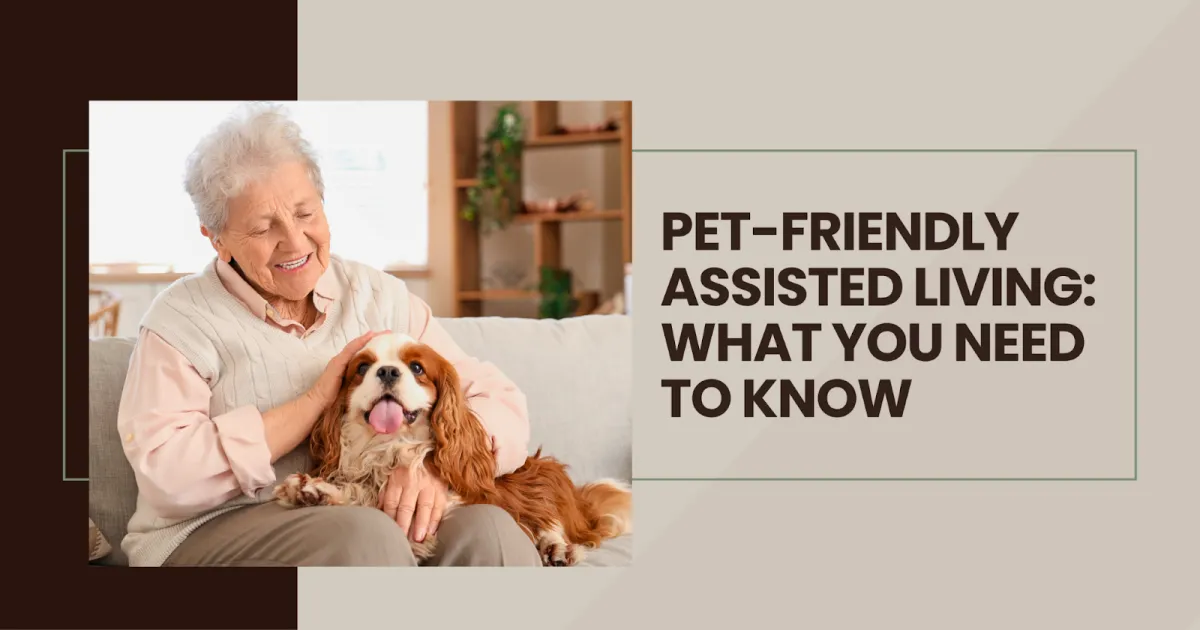
Pet-Friendly Assisted Living: Enhancing Senior Lives
When Margaret, a widow in her 70s, faced the prospect of moving to an assisted living facility, she couldn’t bear the thought of leaving her beloved cat, Whiskers. Most senior communities she visited didn’t allow pets, but she found a place that embraced assisted living with pets and understood the importance of pet care for elderly residents. Bringing Whiskers along not only improved Margaret’s emotional well-being but also highlighted the significant benefits pets bring to seniors. For many, pets are not just companions—they’re vital to mental and physical health, enhancing their overall happiness.
If you or a loved one is considering senior living but can’t imagine life without a pet, this guide covers everything you need to know—from senior living pet policies to pet care for elderly residents.
Why Pets Matter Deeply to Seniors
Pets aren’t just about companionship—they’re about quality of life. For many seniors, pets bring a sense of purpose, joy, and connection. But why are pets so crucial to aging adults?
As we age, several aspects of life change. Family members might move far away, spouses might pass, and physical health may decline. These shifts can lead to loneliness, depression, and a loss of purpose. Pets, however, offer something irreplaceable: unconditional love, routine, and companionship. Whether it’s a dog’s excited greeting at the door or a cat curling up on the couch, pets help seniors feel needed, loved, and connected to the world around them.
Ask Yourself:
Can you imagine your life without your loyal pet by your side, especially in your later years?
For Margaret, Whiskers was more than just a pet; she was a constant reminder of comfort, routine, and unconditional love. The bond between seniors and their pets isn’t just heartwarming—it’s vital.
The Life-Enhancing Benefits of Pets for Seniors
The advantages of pet ownership for seniors are backed by research and can’t be overstated. Let’s explore the tangible benefits pets provide to aging adults.
1. Physical Health Benefits
Owning a pet can significantly boost a senior’s physical health. Pet owners tend to be more active, whether it’s walking the dog or simply playing with a cat. Dogs, in particular, provide an excellent reason to stay physically active. A short walk to the park or a game of fetch in the yard can promote cardiovascular health, help control weight, and maintain joint flexibility.
Many studies have found that pet owners are generally healthier than their non-pet-owning peers. Having a pet encourages seniors to get outside, get moving, and stay physically engaged with life.
2. Mental and Emotional Health Benefits
The emotional benefits of pet ownership for seniors are just as important as the physical ones. Interacting with pets increases serotonin levels and decreases cortisol levels, leading to reduced stress and anxiety. Research shows that seniors who own pets are less likely to suffer from depression, as pets provide constant companionship and an emotional outlet.
3. Combating Loneliness
Loneliness can be one of the most difficult challenges seniors face. It can lead to depression, health decline, and even a shortened lifespan. Pets provide an antidote to loneliness. Whether it’s a dog that demands attention or a cat that wants to snuggle, pets create daily routines and offer companionship that can reduce feelings of isolation.
Moreover, pets can act as a social catalyst. Pet owners are more likely to interact with their neighbors, whether through dog walks, pet-related events, or simply striking up conversations about their pets. This can help seniors build and maintain meaningful connections with others.
4. Cognitive Stimulation
Caring for a pet involves more than just feeding or walking it. Pet owners need to keep track of their pets’ health, appointments, and routines. This responsibility helps seniors stay mentally engaged and alert. The routine of caring for a pet can also provide mental stimulation, which is important in preventing cognitive decline.
Research has shown that the mental exercise involved in caring for a pet can have a positive impact on a senior's cognitive health. For seniors at risk of dementia or Alzheimer’s, pets can provide a sense of purpose and a reminder to stay active both mentally and physically.
5. Restoring Purpose and Joy
In retirement, seniors often face a sense of loss. Whether it's the loss of a spouse, a career, or a sense of independence, aging can feel isolating. Pets restore purpose to seniors’ lives. They give seniors a reason to wake up in the morning, care for something, and feel needed.
The bond formed between a senior and their pet can provide immeasurable joy and satisfaction.
Understanding Common Pet Policies in Senior Living Communities
As more seniors choose to live with their pets, many assisted living communities are adapting their senior living pet policies. However, not all communities are equally flexible. Some have strict rules to confirm the safety and well-being of all residents, both human and animal.
Here are some common policies that you may encounter when looking for a pet-friendly assisted living facility:
When searching for a community, make sure to ask detailed questions about these policies to confirm they align with your needs and expectations.
What to Consider Before Bringing Your Pet Along
Bringing a pet into an assisted living community is a big decision. While pets can improve a senior's life, it's important to confirm that both the pet and the person are ready for the transition. Here are a few things to think about:
1. Physical Ability to Care for Your Pet
Caring for a pet is a responsibility. Feeding, walking, grooming, and providing attention all require time and energy. Seniors with physical limitations may need assistance with pet care. Check whether the community offers services like dog walking, or if family or friends can help out when needed.
2. Backup Plan for Emergencies
What happens if you become ill or need to be hospitalized? Who will care for your pet? Confirm that you have a backup plan in place, such as family members or friends who can step in or a professional pet-sitting service.
3. Available Pet Services
Some communities offer additional services, such as grooming, dog walking, or access to veterinary care. These services can ease the burden of pet ownership and help confirm that your pet's needs are met.
4. Budget for Pet Care
Pet ownership can be expensive. Make sure to budget for pet-related expenses, such as food, medical care, grooming, and any additional fees the community charges. You may want to explore whether your insurance or health care provider offers any assistance with pet care costs.
Tips for Moving to a Pet-Friendly Senior Community
Moving to an assisted living facility that allows pets is an exciting and life-changing step, not just for you but for your furry companion as well. It’s essential to plan the transition carefully, ensuring both you and your pet adjust smoothly to the new environment. Here are several tips to help make the process easier for both of you:
Assess Your Ability to Care for Your Pet: Evaluate whether you can care for your pet independently or if you need assistance.
Confirm Your Pet Is Healthy: Keep vaccinations up-to-date and confirm your pet is flea-free before moving.
Pack a Pet Essentials Bag: Pack all your pet’s essentials, such as food, medications, and toys.
Maintain Your Pet’s Routine: Keep feeding and walking schedules as consistent as possible during the transition.
Locate Nearby Veterinary Services: Know where the closest veterinary clinics and animal hospitals are for emergencies.
Conclusion
Moving to a pet-friendly senior living community can be an exciting new chapter for you and your furry companion. By planning and taking steps to confirm your pet’s comfort and well-being, you can make the transition smoother for both of you. From updating vaccinations to ensuring your pet's routine stays intact, these tips will help you navigate the move with confidence. By focusing on both your needs and your pet’s, you can settle into your new home and create a safe, welcoming environment for your four-legged friend.
Remember to take your time during the transition, communicate with the staff at your new community, and make sure your pet’s needs are met every step of the way. Your pet's happiness and comfort are just as important as yours in this new chapter of life!
Are you ready to explore assisted living facilities with pets for your loved one? Contact us today to learn more about communities that embrace the joy of pets!
FAQs
1. What types of pets are typically allowed in assisted living?
Most communities allow cats and small dogs, but some may permit birds or fish. Exotic pets or larger breeds may have restrictions, so always confirm with the facility beforehand.
2. How do assisted living facilities confirm pets are well cared for?
Many communities have staff who assist with feeding, walking, and grooming. Some also partner with local veterinarians for routine checkups and emergency care.
3. Can I bring my pet if I need memory care or skilled nursing?
Policies vary—some memory care units allow pets, while others may not due to safety concerns. Ask about specialized pet-friendly senior living options for higher levels of care.
4. What happens if my pet becomes aggressive or disruptive?
Facilities may require behavioral training or, in extreme cases, rehoming. Review the community’s pet policy to understand their rules on pet behavior.
5. Are there pet-friendly activities in assisted living communities?
Yes! Many facilities host pet-friendly events like "Yappy Hours," dog walks, or therapy animal visits to encourage socialization among residents and pets.

Facebook
Instagram